
Sponsored Ads
|
» Home
» Bilingual » Hrvojka Mihanovic Salopek: Digital Recording of the Croatian Mariological Heritage
» Home
» Music » Hrvojka Mihanovic Salopek: Digital Recording of the Croatian Mariological Heritage
» Home
» Croatian spirituality » Hrvojka Mihanovic Salopek: Digital Recording of the Croatian Mariological Heritage
» Home
» Croatian Language » Hrvojka Mihanovic Salopek: Digital Recording of the Croatian Mariological Heritage
» Home
» History » Hrvojka Mihanovic Salopek: Digital Recording of the Croatian Mariological Heritage
» Home
» Education » Hrvojka Mihanovic Salopek: Digital Recording of the Croatian Mariological Heritage
» Home
» Culture And Arts » Hrvojka Mihanovic Salopek: Digital Recording of the Croatian Mariological Heritage
| Hrvojka Mihanovic Salopek: Digital Recording of the Croatian Mariological Heritage |
| By Nenad N. Bach and Darko Žubrinić |
Published
07/7/2022
|
Bilingual , Music , Croatian spirituality , Croatian Language , History , Education , Culture And Arts
|
Unrated
|
|
|
|
Under the auspices of the Croatian Parliament and of the Croatian Conference of Bishops
Hrvojka Mihanović Salopek, PhD
Biography of HRVOJKA MIHANOVIĆ - SALOPEK
Hrvojka Mihanović - Salopek graduated in Croatian literature and language at the Faculty of Philosophy, University of Zagreb in 1984. She received her master's degree from the Faculty of Philosophy in 1990. The title of her thesis was Hrvatska himnodija od srednjeg vijeka do preporoda (Croatian Hymnody from the Middle Ages to the National Revival), and she obtained her doctorate in 1998 and her dissertation title was Hrvatska crkvena himnodija 19. stoljeća (Croatian Church Hymnody of the 19th century).
She has been working since 1986 in the Department of Literature, Institute for the History of Croatian Literature, Theater and Music of the Croatian Academy of Science and Arts. Starting as a research associate in 2002, she became a senior research associate in 2008, a scientific advisor in 2013 and was promoted to a permanent scientific advisor in 2018. She lectured part-time at the Summer School of Faculty of Croatian Studies, University of Zagreb in 2008/09. She taught part-time a course of Hymnology at the Catholic Faculty of Theology of the University of Zagreb in the academic year 2009/10. She also lectured part-time at the doctoral study of Faculty of Croatian Studies at the University of Zagreb in 2017. In 1997, she was elected an honorary, corresponding member of the International Mariological Academy in Rome (Pontificia Academia Mariana Internationalis).
She participated in several scientific projects; (from 1986 to 1989 on a scientific project) Sabrana djela Ante Kovačića (Collected Works of Ante Kovačić); (from 1991 to 2001 on a scientific project) Sabrana djela Milana Begovića (Collected Works of Milan Begović) in 24 volumes, and at present she is an associate on the scientific project of the Croatian Academy of Science and Arts, Hrvatski književni povjesničari (Croatian Literary Historians). From 2007 to 2019, she led the international bilateral project The Contribution of Croatian and Bulgarian Intellectuals to the Spiritual Diversity of Europe, a collaboration between the Croatian Academy of Science and Arts (HAZU) and the Bulgarian Academy of Sciences (BAN). She was the leader of international scientific conferences within the event Dvigrad - International Festival of Early Music in Istria under the auspices of the President of the Republic of Croatia.
She the author of 10 scholarly books:
- Hrvatska himnodija (od srednjeg vijeka do preporoda), (Croatian Hymnody from the Middle Ages to the National Revival), Književni krug, Split, 1992 (167 pages) ISBN 86-7397-115-2;
- Hrvatska crkvena himnodija 19. stoljeća (Croatian Church Hymnody of the 19th Century), "ALFA", Edition 'Scientiae et Artes', Zagreb, 2000. (339 pages) ISBN 953-168-235- 6;
- Tihi pregaoci visovačko-skradinskog područja (Doprinos franjevaca hrvatskoj himnodiji i duhovnoj književnosti), (Quiet Contributors of the Visovac-Skradin Region - Contribution of the Franciscans to Croatian Hymnody and Spiritual Literature), (izdanje Franjevačke provincije Presvetoga Otkupitelja, Biblioteka "Ravnokotarski Cvit", knj. br.15, Split, 2004. (96 pages) ISBN 953-6012-28-6;
- Iz duhovnog perivoja (From the Spiritual Park), Biblioteka "Posebna izdanja", Ljevak, Zagreb, 2006. (293 str.) ISBN 953-178-769-7
- Doprinos Petra Kanavelića hrvatskoj pasionskoj baštini (u suautorstvu s dr. Vinicijem Lupisom), (Contribution of Petar Kanavelić to the Croatian Passion Heritage, (in co-authorship with Dr. Vinicije Lupis), Ogranak Matice hrvatske, Split, 2009 (303 pages) ISBN 978-953-6159-94-5;
- Željezni duh. Doprinos Jakete Palmotića Dionorića hrvatskoj književnoj baštini (u suautorstvu s dr. Vinicijem Lupisom). (Iron Spirit. The contribution of Jaketa Palmotić Dionorić to the Croatian literary heritage), (in co-authorship with Dr. Vinicije Lupis), Ivo Pilar Institute in Dubrovnik, Zagreb - Dubrovnik, 2010 (474 ââpages) ISBN 978-953-6666-67-6,
- U ogledalu kritike (In the Mirror of Criticism), "Association Prosoli", Zagreb, 2012/13. (263 pages) ISBN 978-953-56249-3-6
- Fr Petar Knežević - Gospin pjesnik i književnik (u suatorstvu s dr. sc. Hanom Breko-Kustura i fra Mirkom Marićem). (Fr. Petar Knežević - Our Lady's Poet and Writer, (in collaboration with Dr. Hana Breko-Kustura and Fr. Mirko Marić); Ogranak Matice hrvatske u Sinju, Sinj, 2017 (451 pages) ISBN 978-953-7440-22-0
- U ogledalu znanstvenih prosudbi (In the Mirror of Scientific Judgments), Biakova, Zagreb, 2018 (p. 381) ISBN 978-953-8136-33-7
- Kristalni plov (The Crystal Float), Umjetnička djelatnost Branke Beretovac, prvakinje HNK u Zagrebu (Artistic activity of Branka Beretovac, the leading lady of the Croatian National Theater in Zagreb), Biakova d.o.o., Zagreb, 2019 (310 pages) ISBN 978-953-8136-90-0
She has also prepared 37 books of selected works, monographs and collections of papers. She has published 112 original scientific papers in foreign and domestic journals and proceedings and 224 professional papers. She is included in the lexicon Who is Who in Croatia, 1993. p. 480 and in the Literary Encyclopedia of the Lexicographic Institute, vol. III, p. 79.
She speaks English and has given scientific lectures at several international conferences: at the Mariological Congress in Kevelaer (Germany) in 1987; in Huelva, near Seville (Spain) in 1992; in Czestochowa-Poland, 1996; in Rome, 2000 and 2004; in Lourdes (France, 2008), at the International Association for the Advancement of Slavic Studies in Boston, USA, 1996; at the International Conference of the Department of Slavic Philology of the University of Lorand Eotvoes in Budapest in 2003; at the Slavic Conference in Pecs in 2002; at the International Bulgarian-Croatian Conference in Sofia in 2008, 2011, 2013, 2015 and 2017; at the International Symposium in Čiprovci, 2009; at the International Symposium on Ivo Frangeš in Trieste, 2012; at the International Symposium in Petrovaradin and Novi Sad, 2015.
She often participates in numerous domestic, international Slavic and Croatian scientific conferences, eg: "Days of the Hvar Theater"; Jesuits in the religious, scientific andcultural life of Croatians; Reception of Milan Begović; Religious themes in literature; Croatian literary baroque and Slavonian literature of the 18th century; Literature in Osijek and about Osijek from the beginning to the present day; Conference on Andrija Kačić - Miošić, Strossmayer Days, "Croatian Literary Historians" (scientific conferences on Franjo Fancev, Tomo Matić, Albert Haler, Branko Drechsler Vodnik, Ivan Milčetić, Milan Rešetar, Šime Ljubić, Ivo Frangeš, Antun Barac, Đuro Šurmin, Milorad Medina, Slavko Ježić and others. She also participated at symposia on Tomo Babić, Petar Knežević, Josip Banovac, Petar Bačić, Ivan Ančić, Emerik Pavić, "Nazor Days" (Postire, 1996 and 1999), at the International Scientific Interdisciplinary Symposium Croatian folklore and ethnographic heritage in the light of Dubrovnik's world and tourism presence, in 2012 and 2013; at the international conference "Passion Heritage" in Subotica in 2013; and at professional gatherings "Days of Josip and Ivan Kozarac" in Vinkovci, "Đakovo Meetings of Croatian Literary Critics", literary meetings "Good Morning Sea" (Podstrana near Split), "Kačić Days", "Croatia Rediviva" (Brač), "Struga Literary evenings" (Macedonia), etc.
She was a part-time associate of the Croatian Radio Television (HRTV) of its Science and Education Program, where she wrote several shows and literary portraits as a screenwriter: (I bow to the queen - Croatian Christmas songs; In death we dream - Croatian songs on death through the history, Krka upstream - literary portrait of Nikola Pulić, The Noble Thread of a Cobweb - Literary Portrait of Višnja Stahuljak and others. Since 2005, she has been the screenwriter, director and leader of the project "Digital Recording of Croatian Mariological Heritage" under the auspices of the Committee on Education, Science and Culture of the Croatian Parliament and the Council of Culture of the Croatian Bishops' Conference, where she realized 12 scholarly educational films on the subject of multidisciplinary presentation of the veneration of the Marian heritage in Croatian dioceses and counties:
- Stella Maris of Croatian Zagorje (spiritual poetry about the Mother of God),
- Stella maris of the Northern Adriatic (spiritual poetry about the Mother of God),
- Dubrovnik's Great Protectress (Marian heritage of Dubrovnik)
- Stella Maris of Dalmatia, part 1 (Marian heritage in the Split-Makarska archdiocese),
- Stella Maris of Dalmatia, part 2 (Marian heritage in the Šibenik diocese)
- Stella Maris Dalmatia, part 3 (Marian heritage in the Zadar archdiocese),
- Stella Mmaris of Slavonian cereal fields (Marian heritage in the Đakovo-Osijek archdiocese),
- Stella maris of the southern islands (Marian heritage of the former Korčula diocese),
- Sisak Mother of Mercy (Marian heritage of the Sisak diocese),
- Varaždin Regina angelorum (Marian heritage of the Varaždin diocese),
- Lika mother of consolation (Marianheritage of the Gospić-Senj diocese),
- Our Lady of the Stone Gate in Zagreb (Marian heritage of Zagreb).
She also directed the film Sinfonia croatica et christiana about the work of academic painter Josip Botteri Dini.
As an external collaborator, she prepared several professional units for the Croatian Biographical Lexicon, for the General Encyclopedia and Literary Encyclopedia of the Lexicographic Institute "Miroslav Krleža", and for the Lexicon of Croatian Writers, Školska knjiga, 2000. She accompanied with a foreword more than 60 books of prescribed readings and newly published fiction for the following publishing houses: "Ljevak", "Školska knjiga", "Mladost", "Znanje", "ABC - naklada", "Mozaik", "Laus", "Albatros", "Nova stvarnost", "Neretva"; "Alfa", Naklada Bošković, "Privlačica d.o.o.", "Panonius", Naklada Haid, "Biakova d.o.o.", etc. For the publishing house "Mozaik" she prepared two manuals for teachers for the series "Zlatna lađa" (reading works by Ivana Brlić Mažuranić and Vladimir Nazor).
From 1988 to 1998 she was a member of the editorial board of the magazine Umjetnost i dijete (Art and the Child), and since 2003 she has been an associate and occasional editor of the professional magazine Musica sacra in Zagreb. Since 2011 she has been a member of the Council of the Školski vjesnik (School Gazette), a pedagogical journal of the Faculty of Philosophy, University of Split. From 1995 until today, she has been a regular member of the National Committee for Children's Books of the Republic of Croatia. Since 2018, she has been a member of the editorial board for anthologies published by the Pasionska baština (Passion Heritage Association). He participates as a reviewer and associate member in the work of the international editorial board of the Bulgarian scientific journal Bulgarian Historical Review, Institute for Historical Studies (BAN) in Sofia.
She is a member of the Društvo hrvatskih književnika (Society of Croatian Writers), a member of the Society of Croatian Women Intellectuals (which is a full member of the International Federation of University Women based in Geneva). Since 2006 she has been an honorary member of Matica slovačka (Slovak Heritage Foundation) in Zagreb. She is a full member of the Croatian Mariological Institute at the Catholic Faculty of Theology at the
University of Zagreb. Since 2007 he has been participating as a promoter and co-organizer in the work of literary and cultural forums of the Croatian Pan-European Union in Zagreb. Along with literature, she completed her organ studies in 1984 at the Institute of Church Music at the Catholic Theological Faculty of the University of Zagreb. She has been a member of the Croatian Association of Music Artists since 1986. She has distinguished herself with a number of notable concerts at home as well as abroad (Austria, France, Hungary, Germany, Spain, Poland, the Czech Republic, Argentina and the USA). She made four CD recordings published by Croatian Radio Television and Musica sacra d.o.o.
She won the bronze medal "Mila Gojsalić" of the Poljica Association in 2012; "Petar Kanavelić" Award for 2016 (Rijeka Writers' Association and Korčula City Government); Silver Charters - Matica hrvatska (Croatian Heritage Foundation) awards Zagreb, 2009 and 2018 for literature; She received the "Special Recognition for Publishing Enterprise" for Selected Works of Miroslav S. Mađer, I. - IV., at the Days of Croatian Books and Words of the Institute for the Culture of Vojvodina Croats in Subotica 2019. In 2019, she was awarded the Order of the Croatian Interlace for the promotion of Croatian culture.
Since 2023, she serves as the president of the Croatian Writers' Society (Društvo hrvatskih književnika, abbreviated DHK), Zagreb.
|
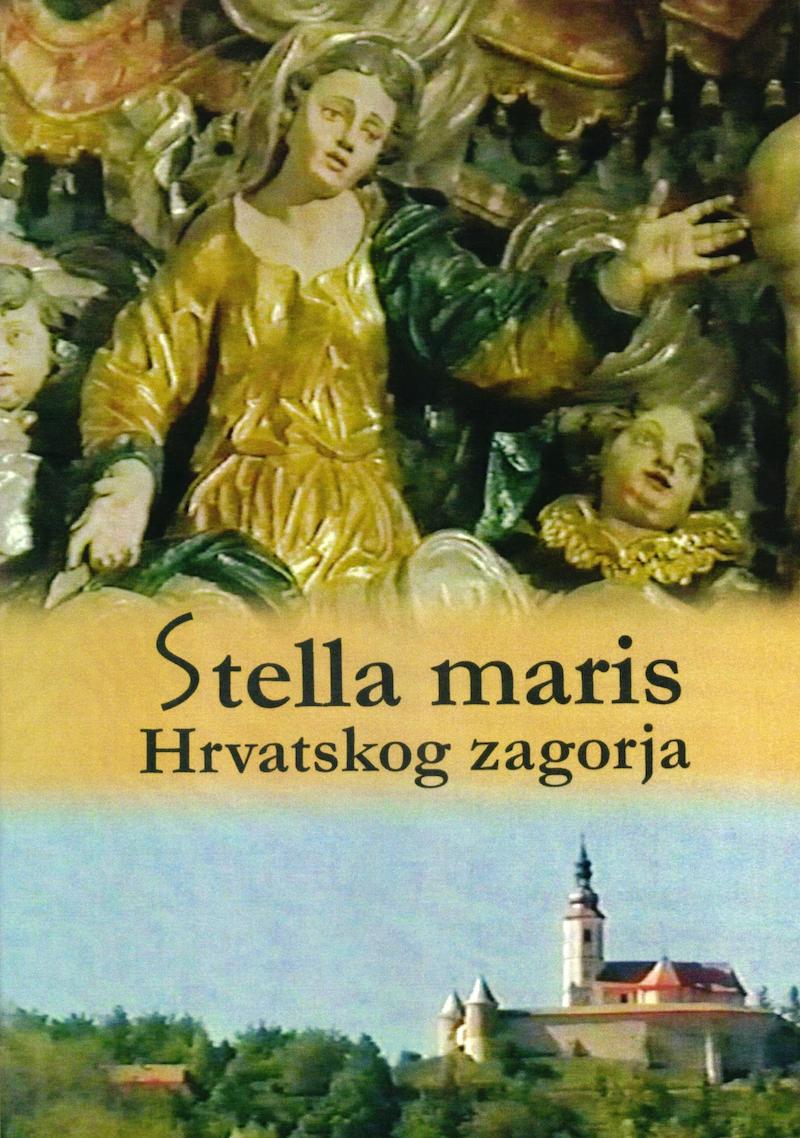
Sažetak. Hrvatsko zagorje, 1. film iz serijala Digitalno snimanje hrvatske mariološke baštine.
Film Stella maris Hrvatskog zagorja prikazuje štovanje Bogorodice koje na sjeverozapadu Hrvatske doživljava osobit umjetničko-izražajni rascvat u baroknom razdoblju Katoličke obnove u 17. i prvoj polovici 18. st. U filmu dobivamo uvid u znamenita djela hrvatskokajkavske duhovne književnosti (Jurja Habdelića, Ivana Belostenca, Mihaela Šimunića, Nikole Bengera, Hilariona Gašparottija, Petra Berkea, pjesmarice Cithare octochorde, Molitvenika grofice Drašković, etc.). Pored raritetnih knjiga upoznajemo i vrijedna djela iz likovne i glazbene baštine posvećene Bogorodici, kao i stvaralačku prisutnost pučke pobožnosti. (Produkcija. HRTV - Zagreb)
Summary. The film Stella Maris of the Croatian Hinterland (Stella maris Hrvatskog zagorja) shows the reverence of the Mother of God in northwestern Croatia where the artistic expression was especially flourishing in the baroque era of the Catholic Renewal in the 17th and the first half of the 18th century. The film gives us an insight into the well-known works of the Croatian kajkavian spiritual literature of Juraj Habdelić, Ivan Belostenec, Mihael Šimunić, Nikola Benger, Hilarion Gašparotti, Petar Berke and the Cithara octochorda song-book, Countess Drašković Prayer-book, etc. Beside the collection of rare books we are introduced to the distinguished works of visual arts and musical heritage dedicated to the Mother of God as well as to the expressions of common-people piety.
|  Sopranistica Estera Pilj Varljen, graditelj orgulja Ivan Heferer i Hrvojka Mihanović-Salopek snimaju glazbenu točku za film Stella maris Hrvatskog zagorja 2003. na orguljama prve hrvatske gradione orgulja "Heferer". Crkva Sv. Križ Začretje.
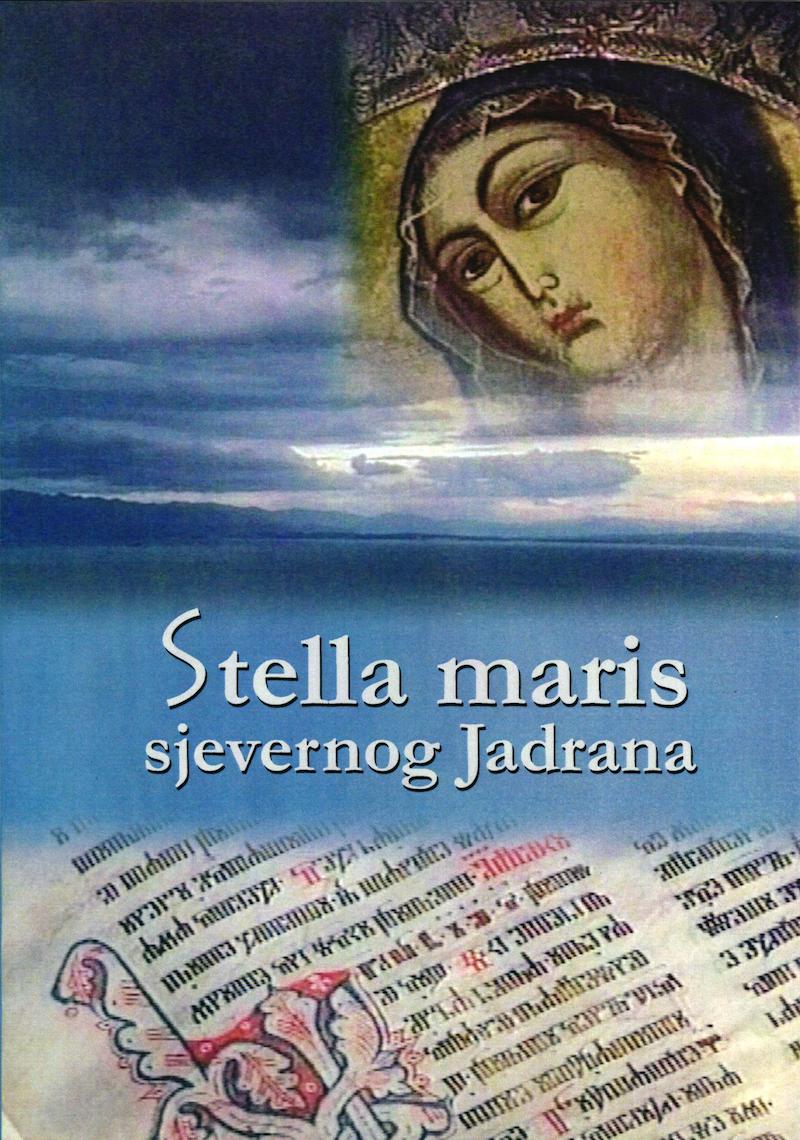
Sažetak. 2. film
Film Stella maris sjevernog Jadrana prikazuje pojedina istaknuta, ali i neka nedovoljno poznata marijanska svetišta s područja Istre i Kvarnera. Kroz odlomke stihova upoznajemo marijansku pobožnost sačuvanu u srednjovjekovnim hrvatskoglagoljskim misalima (Ročki misal iz 15. st., Beramski misal iz 15. st., Vrbnički misal iz 15. st., Oficij blažene devi Marije iz 1530. biskupa Šimuna Kožičića Benje, Tkonski zbornik iz poč. 16. st., Osorska pjesmarica iz poč. 16. st., Molitvenik Hortulus animae iz 1560. Nikole Dešića, etc.). U filmu su snimljena i znamenita likovna djela posvećena Bogorodici, a osobito poznate istarske srednjovjekovne freske. Posebice je istaknut povijesni pregled značajne hodočasničke Crkve Majke Božje Trsatske. Pored toga u filmu slušamo glazbena duhovna djela karakteristična za sjevernojadransko podneblje: zvuk sopila i roženica koje prezentiraju staru istarsku ljestvicu, glagoljaško pjevanje vrbničkog zbora s otoka Krka, gregorijansko pjevanje redovnika i redovnica, te djela renesansno-baroknih skladatelja Andrije Motovunjanina i fra Gabriella Pulitija. (Produkcija: HRTV - Zagreb)
Summary. The film Stella maris sjevernog Jadrana (Star of the Northern Adriatic) shows well-known and some not so well-known Marianist shrines in Istria and Kvarner. The verses give us a glimpse of Marianist piety recorded in the medieval Croatian-glagolitic missals (Ročki Missal, 15th cent., Beram's Missal, 15th cent., Vrbnik's Missal, 15th cent., Bishop Šimun Kožičić's Official of the Holy Virgin, 1530, Tkon's Anthology, 16th cent., Osor's Song-book, 16th cent., Nikola Dešić's Prayer-book, 1560 and others). The film shows known art works dedicated to the Mother of God including the well known medieval Istrian frescoes. Historical survey of the Shrine of the Our Lady of Trsat is given. We also hear musical works which are characteristic for the region of Northern Adriatic: the sound of Istrian long flute (sopile) representing the old Istrian scale, glagolitic singing of Vrbnik's Choir from the island of Krk, Gregorian chant of friars and nuns and the works of the Renaissance and Baroque composers Andrija from Motovun and Fr. Gabriello Puliti.
| 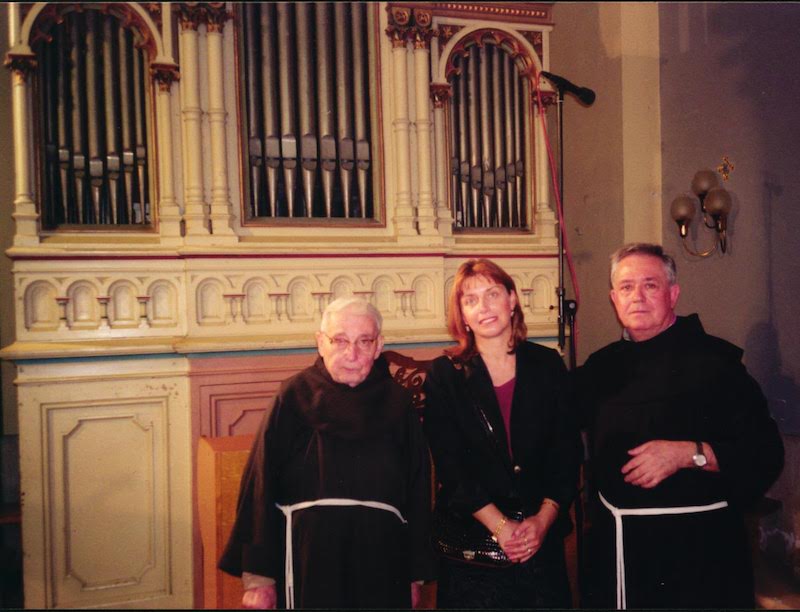 Proslava 500. obljetnice Franjevačkog samostana u Makarskoj, 20. listopad 2002. S lijeva na desno: fra Pavao Melada, dugogodišnji predsjednik Međunarodne mariološke akademije u Rimu.
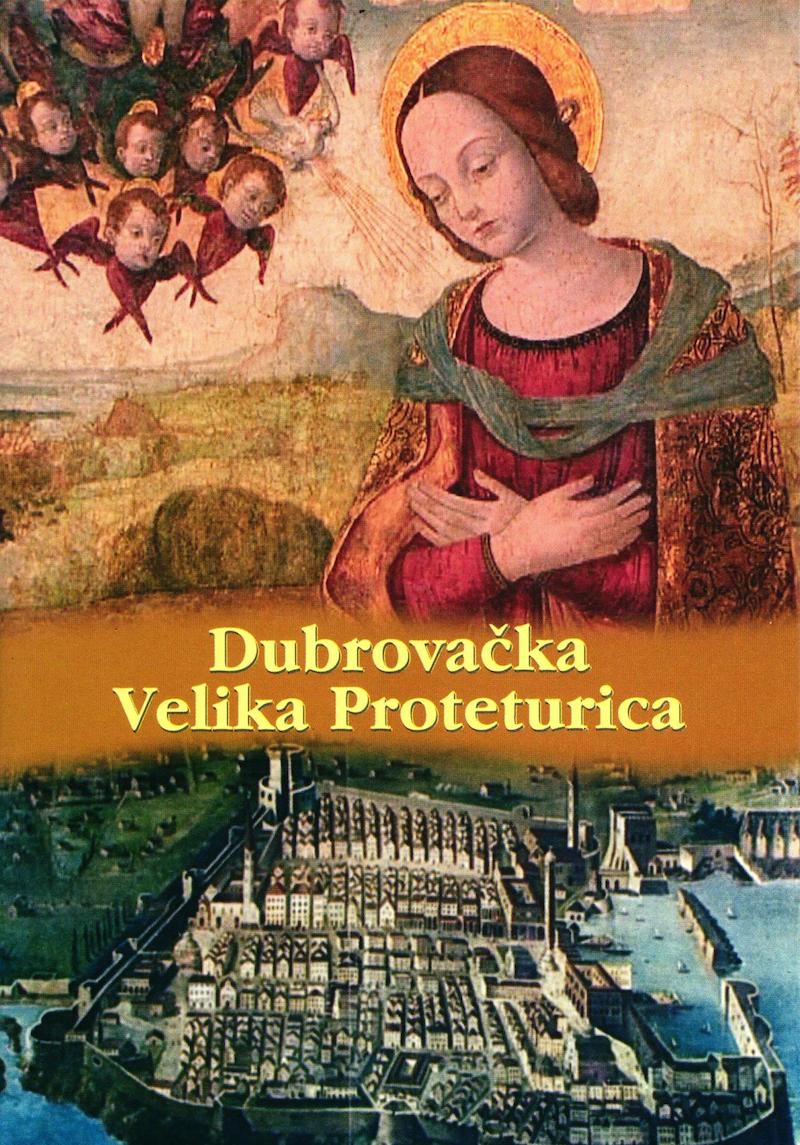
Sažetak. Štovanje Gospe u Dubrovniku, 3. film.
Film Dubrovačka velika proteturica (zaštitnica, od lat. protegere) nazvan je prema izrazu hrvatskog književnika Ive Vojnovića, kojim on u svojem pismu dijalektalno oslovljava Bogorodicu - Gospu Lapadsku. U filmu je obrađeno štovanje Bogorodice u gradu Dubrovniku tijekom zlatnog razdoblja Dubrovačke republike u 15. i 16. st. pa do današnjih dana. Film prikazuje znamenita marijanska svetišta i crkve, te antologijski izbor djela iz teološke, književne (renesansno-petrarkističke), likovne i glazbene baštine posvećene Bogorodici.
U filmu su snimljene raritetne knjige i rukopisi kardinala Ivana Stojkovića (Johannes Stojci), Serafina Crijevića, Mavra Vetranovića, Đore Držića, Paskoja Primovića-Latinčića, Bernarda Sorkočevića, opata Stjepana Gradića, Arkanđela Gučetića, Ignacija Aquilinija i Arkanđela Kalića. Pored toga film nas upoznaje s najslavnijim Gospinim slikama dubrovačkih renesansnih umjetnika: Nikole Božidarevića, Lovre Dobričevića, Matka Junčića, Božidara Vlatkovića i drugih, kao i glazbu renesansnog Dubrovnika.
(Produkcija: Udruga Prosoli - Sveta glazba, Zagreb)
Summary. The film Dubrovačka velika proteturica (Dubrovnik's Great Protectress) owes its name to Croatian writer Ivo Vojnović who addresses Our Lady of Lapad in one of his letters written in a dialect. The film shows the reverence of the Mother of God in Dubrovnik during the golden age of the Republic of Ragusa in 15th and 16th centuries until the present times. Shown are the famous Marianist shrines and churches and a selection from theological, literary, artistic and musical works dedicated to the Mother of God.
Included are the rare books and manuscripts of Cardinal Ivan Stojković (Johannes Stojci), Serafin Crijević, Mavro Vetranović, Đore Držić, Paskoje Primović-Latinčić, Bernard Sorkočević, Fr. Stjepan Gradić, Arkanđel Gučetić, Ignacio Aquilini and Arkanđel Kalić.The film shows us the famous paintings of the Mother of God whose authors are the famous Dubrovnik's renaissance artists: Nikola Božidarević, Lovro Dobričević, Matko Junčić, Božidar Vlatković and others.
| 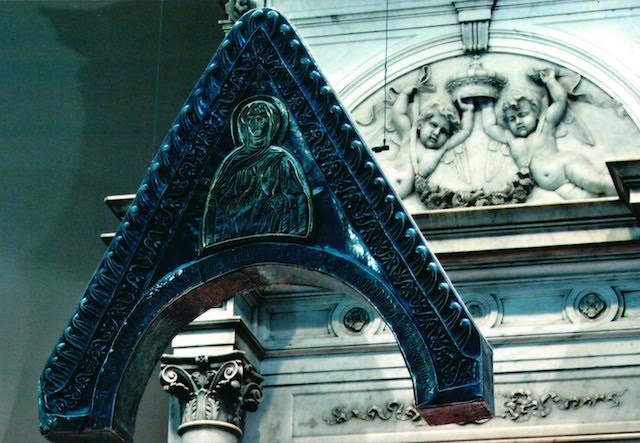
(Pontificia Academia Mariana Internationalis), dr. sc. Hrvojka Mihanović-Salopek,
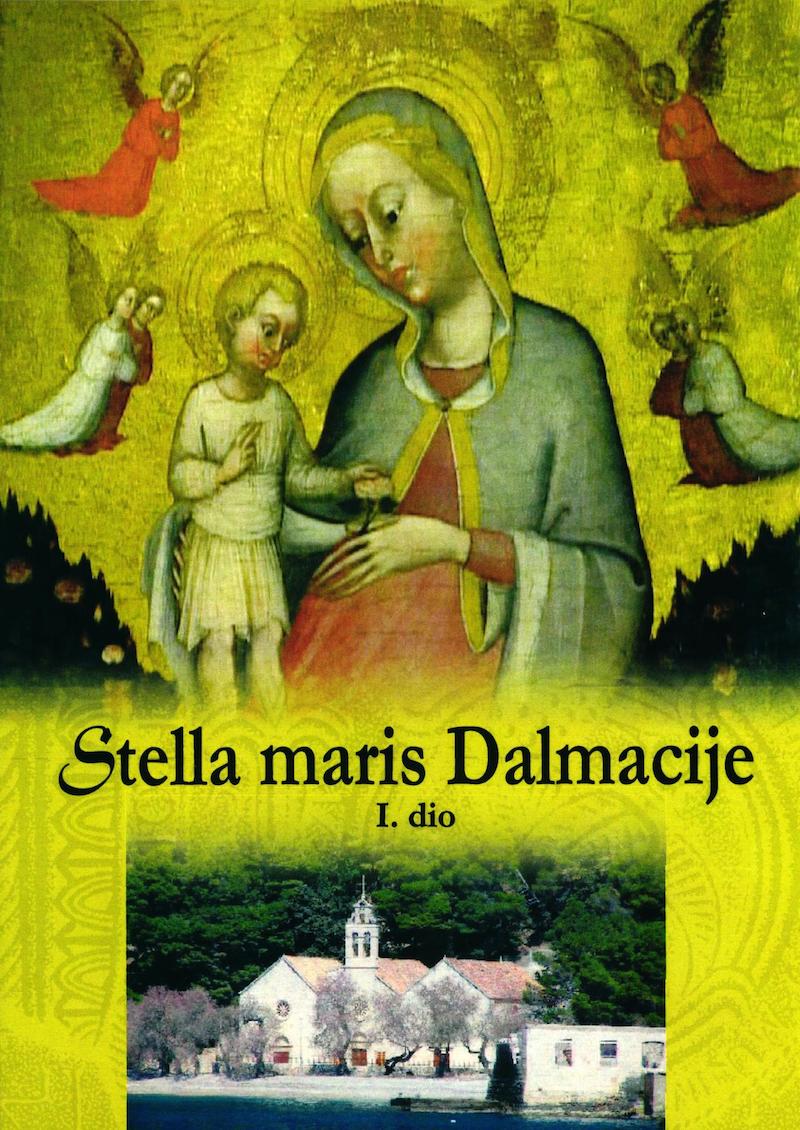
Sažetak. Splitsko-makarska nadbiskupija (4. film)
Film Stella maris Dalmacije I. dio, prikazuje štovanje Bogorodice u Splitsko-makarskoj nadbiskupiji i Hvarskoj biskupiji od srednjeg vijeka preko renesanse do današnjih dana. U snimkama su predstavljena znamenita marijanska svetišta, te antologijski odabir djela iz iz teološke, književne, likovne i glazbene baštine posvećene Gospi.
U filmu su snimljeni kameni spomenici na čast Bogorodici iz vremena hrvatskih vladara, te rijetke knjige i rukopisi: Marka Marulića, Frane Božičevića Natalisa, Ivana Lucića, Koriolana Ćipika, Petra Lucića Trogiranina, Ivana Lulića, Mateja Albertija Matulića, Dominika Armanova, Hanibala Lucića, Petra Hektorovića, Hortenzija Brtučevića, Lovre Grizogona, Andrije Vitaljića, Bone Razmilovića, Filipa Grabovca, Andrije Kačića-Miošića, Petra Kneževića, Mateja Čulića, kao i najstarijeg Splitskog evanđelistara (580.-600.god.) i Trogirskog evanđelistara (11. do 13.st.). Film nas upoznaje i s likovnim djelima srednjovjekovnih majstora Radovana i Andrije Buvine, te Blaža Jurjeva Trogiranina, Ivana Duknovića, Andrije Alešija, Nikole Firentinca, Girolama de Santa Crocea, Jacopa Tintoretta, Benedetta Diane, Antonija Molinariusa, Mateja Pončuna i drugih. U glazbenim snimkama prisutna je tradicija koralnog pjevanja i specifičnog glagoljaškog pjevanja očuvanog u pučkoj tradiciji. (Produkcija: Udruga Prosoli - Sveta glazba).
Summary. In the scholarly educational film Stella Maris Dalmatia, Part I. is presented mariology in the Diocese od Split, starting with the medieval Croatian rulers, through the Gothic, Renaissance and early baroque achievements until the present day.
The film shows notable Marian churches, and an anthological selection from the works of the literary historical, theological, artistic and musical heritage. It also presents old rare books, manuscripts and writers, such as Marko Marulić, Frane Božičević Natalis, Ivan Lucić, Koriolan Ćipiko, Petar Lucić Trogiranin, Ivan Lulić, Matej Alberti Matulić, Dominik Armanov, Hanibal Lucić, Petar Hektorović, Hortenzije Brtučević, Lovro Grizogon, Andrija Vitaljić, Bono Razmilović, Filip Grabovac, Andrija Kačić-Miošić, Petar Knežević, Matej Čulić, and the medieval Croatian missals: Splitski evanđelistar (6th century) i Trogirski evanđelistar (11th till 13th centuries).
The film also presents Gregorian chant, the oldest of which were noticed (recorded) in the croatian codex from the late 10th and early 11th centuries, as well as Early Croatian Glagolitic singing preserved in the folk tradition.
|
 Snimateljska ekipa nakon snimanja filma Stella Maris Dalmacije 1. dio na audijenciji kod mons. dr. sc. Marina Barišića u Nadbiskupiji u Splitu 2007. S lijeva na desno sjede: Vesna Mahečić, pomoćnica redatelja, mons. Marin Barišić, nadbiskup splitsko-makarski,
dr. sc. Hrvojka Mihanović-Salopek, voditeljica projekta, scenaristica i suredateljica, ing. Tea Ganza, pomoćnica snimatelja;
stoje s lijeva na desno: Boris Poljak, snimatelj, Miroslav Mahečić, redatelj, ing. Dean Ganza, umjetnički fotograf i snimatelj, Alojzije Prosoli, producent. 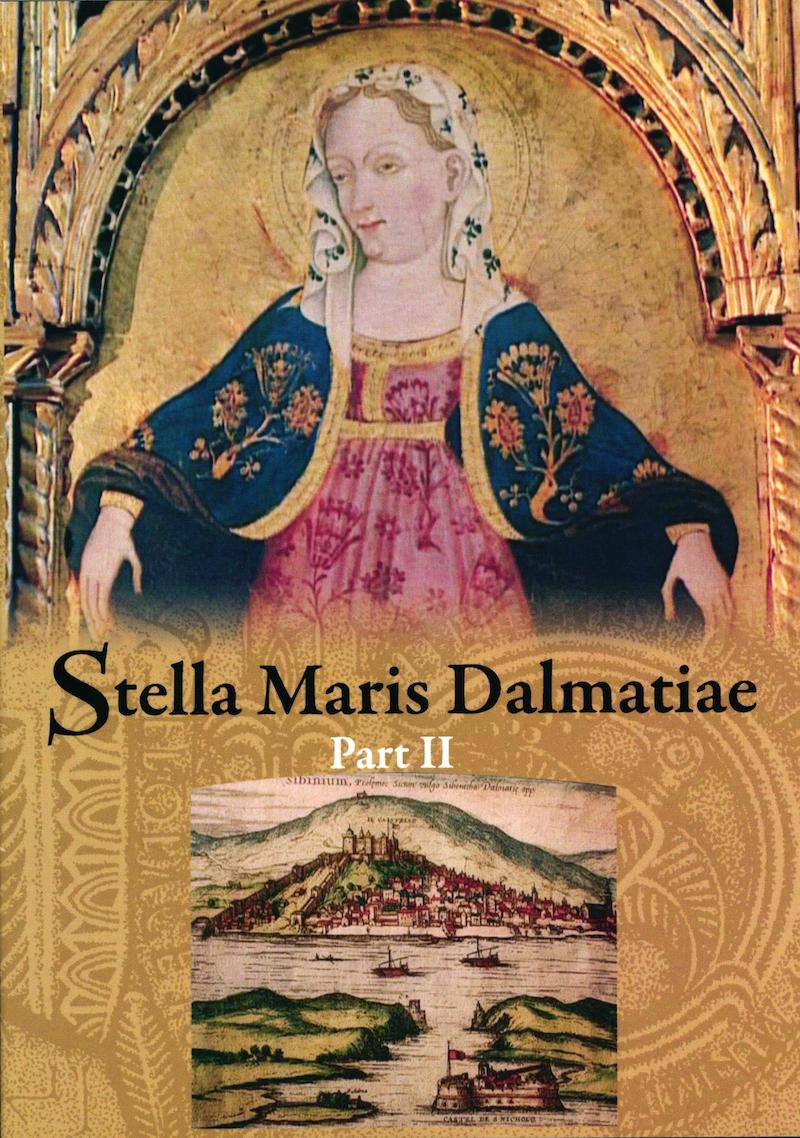
Sažetak. Šibenska biskupija (5. film iz serijala)
U znanstveno-obrazovnom filmu Stella maris Dalmacije II. dio prikazano je štovanje Bogorodice u Šibenskoj biskupiji od srednjovjekovnih hrvatskih vladara, preko gotike, renesanse i ranobaroknih ostvarenja do današnjih dana. U snimci upoznajemo znamenite marijanske crkve, nizove Marijinih titulara i metafora, te antologijski izbor iz djela književnopovijesne, teološke, likovne i glazbene baštine.
U filmu su snimljene knjige i stihovi Šibenske molitve iz 14. st., Jurja Šižgorića, Petra Divnića, Fausta Vrančića, fra Matije Divkovića, fra Pavla Posilovića, fra Tome Babića, fra Petra Jurića, fra Josipa Banovca, fra Petra Kneževića, pa do novijih tekstova o Bogorodici Vinka Nikolića i kipara Ivana Meštrovića.
Pored toga film nas upoznaje s marijanskim djelima poznatih kipara i slikara Jurja Dalmatinca, Nikole Firentinca, Nikole Vladanova Šibenčanina, Jurja Čulinovića, Blaža Jurjeva Trogiranina, Martina Kolunića Rote, Božidara Bonifačića, Orazia Fortezze (šibenskog zlatara), Matije Pončuna, Joze Kljakovića, Ivana Meštrovića i brojnih drugih
U glazbenim snimkama pratit će nas zvuci gregorijanskog korala čiji najstariji zapisi potječu iz šibenskog kodeksa Liber sequentiarum s kraja 10. na 11. st., ali i tragovi starohrvatskog glagoljaškog pjevanja očuvani u pučkoj tradiciji. U filmu ćemo čuti tonove renesansnih leuta i citri, motet Ivana Lukačića s početka 17. st., izvorni zvuk orgulja šibenskog orguljara Petra Nakića iz 18. st. (Produkcija: Udruga Prosoli - Sveta glazba i Sveta glazba d.o.o.)
Summary. In the scholarly educational film Stella Maris Dalmatia, Part II, veneration of Our Lady in the Diocese of Šibenik is presented, starting with the medieval Croatian rulers, through the Gothic, Renaissance and early baroque achievements until the present day. We become acquainted with notable Marian churches, titles and metaphors, and an anthological selection from the works of the literary historical, theological, artistic and musical heritage.
It also presents books and verses, such as the Šibenik Prayers (Šibenske molitve) from the 14th century, Juraj Šižgorić, Petar Divnić, Faust Vrančić, Fr. Matija Divković, Fr. Pavao Posilović, Fr. Toma Babić, Fr. Petar Jurić, Fr. Josip Banovac, Fr. Petar Knežević, and newer works honoring Our Lady by Vinko Nikolić and the sculptor Ivan Meštrović.
In addition, the film acquaints us with Marian works by the distinguished sculptors and painters Juraj Dalmatinac, Nikola Firentinac, Nikola Vladanov Šibenčanin, Juraj Čulinović, Blaž Jurjev Trogiranin, Martin Kolunić Rota, Božidar Bonifačić, Orazio Fortezza (Šibenik goldsmith), Matija Pončun, Jozo Kljaković, Ivan Meštrović and numerous others.
The film also presents Gregorian chant, the oldest of which were recorded in the Šibenik codex from the late 10th and early 11th centuries, as well as Early Croatian Glagolitic singing preserved in the folk tradition. We shall also listen to the tones of Renaissance lutes and cithers, an early 17th century motet by Ivan Lukačić and the original sound of an organ built by Petar Nakić during the 18th century.
| 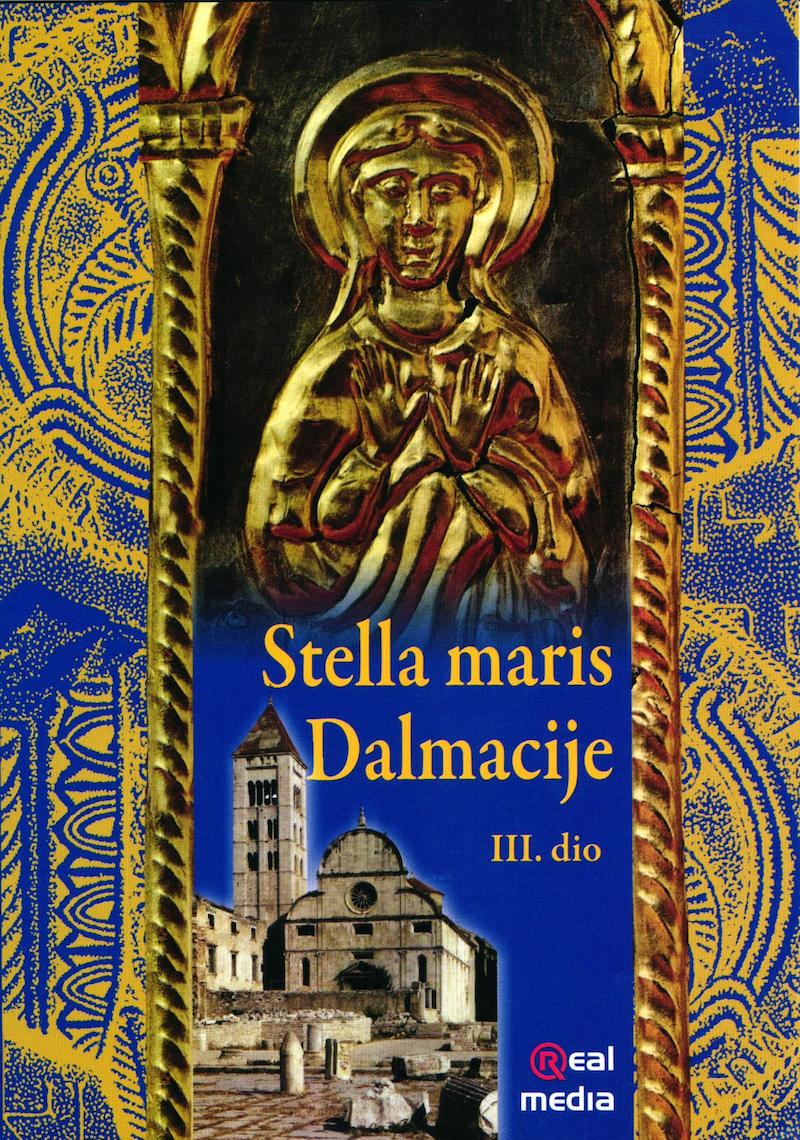
Sažetak. Zadarska nadbiskupija (6. film)
U znanstveno-obrazovnom filmu Stella maris Dalmacije III. multidisciplinarno je prikazan presjek građe posvećen povijesnom štovanju Bogorodice u Zadarskoj nadbiskupiji. Kroz film upoznajemo pojedina glasovita zadarska povijesna marijanska svetišta, izbor važnih knjiga (među ostalim i vrlo staru mariološku raspravu Benedikta Benkovića Navigium Beate Marie Virginis, objavljenu 1498.), nizove Marijinih titulara ukorijenjenih u pobožnost, prikaz muzejskih zbirki i proslavljenih marijanskih slikarskih djela (od vremena starohrvatskih vladara, pa do slikarstva Dujma Vuškovića, Ivana Petrova, Blaža Jurjeva Trogiranina, Maestra di San Elsina, Petra de Riboldisa, Pavla Veneziana, Petra Jordanića, Palme Mlađeg, Ivana Pribislavića, Jurja Čulinovića i drugih). Kroz glazbu pratit ćemo gregorijansko pjevanje, čiji najstariji zapisi potječu iz Molitvenika opatice Čike i Većenegina brevijara iz 11. i 12. st., a pored toga i baštinu srednjevjekovnoga glagoljaškog pjevanja, očuvanog u tradiciji crkvenih narodnih pjevača. Prikazan je i izbor dojmljivih marijanskih stihova koje su napisali pjesnici zadarskoga književnog kruga: Šime Budinić, fra Ivan Zadranin, Mihovil Bilanović, Bartol Kašić i drugi. Posebna pozornost posvećena je djelima srednjovjekovnoga zlatarstva Zadra i Nina, koji su se kroz povijest ponajviše očuvali velikim zalaganjem benediktinki Samostana sv. Marije u Zadru. (Produkcija: Udruga Prosoli - Sveta glazba; Real media d.o.o.)
Summary. In the scholarly educational film Stella Maris Dalmatia, Part III, veneration of Our Lady in the Zadar Archdiocese presents an anthological selection from the works of the literary historical, theological, artistic and musical heritage from the medieval Croatian rulers, Middle Ages, through the Renaissance and early baroque achievements until the present day. We become acquainted with notable Marian churches, titles and metaphors, and an anthological selection from the works of the literary historical, theological (for example rare book Navigium Beate Mariae Virginis, work by Zadar franciscan Benedikt Benković dated 1498) , artistic and musical heritage. The musical selections include the choral tradition ( Prayer Book of Abess Čika, Croatian noblewomen, and the Breviary of Većenega, from 11th and 12th century) and specific Glagolitic singing preserved in the folk tradition. It also presents verses and old writers such as Šime Budinić, fra Ivan Zadranin, Mihovil Bilanović, Bartol Kašić. The film also presents silver and gold filigree works which the Nuns of the Benedictine convent St. Mary of Zadar safeguarded.
|
Please, go to the next page below.
|
|
|
|
|